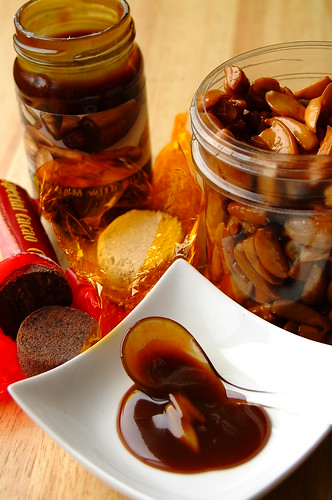
C was on a business trip last week in Naga, a city in the Bicol region of the Philippines. Naga is a leg-numbing 8-hour drive from Manila (where we live), unless there is traffic (which is often, especially in last Friday’s rains), in which case the ride can stretch to 10 hours.
***The Bicol region has some gorgeous natural gems such as: Mayon Volcano (with a nearly perfect cone!), the incredible butanding (whalesharks) of Donsol, and a great many beautiful beaches and idyllic islands. If you are sports minded these are great spots for surfing (in Daet, Camarines Norte), diving, and wakeboarding (Camarines Sur is now a popular wakeboarding and wakeskating destination). So despite the long drive, I would definitely love to see it one day (you can fly too if you’ve got extra moolah on you).***
Anyhoo, back to reality, and a rain soaked Friday evening. I had just finished a full day meeting and C was on his way back from Naga, stuck in traffic, tired and hungry. He finally gets home at past 9 in the evening and we are just about ready to slay a cow with our bare hands. Hunger, fatigue, and metaphorical cow-slaying aside, I was delighted to see the stash of regional delicacies C had (thanks guy!) brought back for me.
My loot:
- Polvoron – Best described as a “powdered milk candy”, polvoron is made of (you guessed it) powdered milk, flour, sugar, butter, and perhaps some sort of flavoring. Some have crushed bits of pinipig (puffed rice) which give it a great crunch. The flour is toasted, the ingredients are mixed, and the resulting fragile powdery blend is stuffed into special oval-shaped molds. It’s like eating sweet, solid, milk…yum! (well, yum if you like milk)
- Tablea – These are blocks of crushed local cacao beans. They are used to make hot chocolate and champorado (our local version of chocolate rice pudding). These blocks are grainy and intense, turning out a hot chocolate that is earthy and rustic. This type of hot chocolate reminds me of my youth, when I would dip heavily buttered toast into it, watching the beads of melted butter float on the chocolate’s surface before sipping it up. I will be making a cup for breakfast very soon!
- Candied Pili Nuts with Honey – Pili nuts are native to the Philippines, and although they are grown as ornamental trees in other tropical countries like Malaysia, only in the Philippines are they produced and processed commercially. All this production take place mainly in the Bicol region, making pili products one of Bicol’s most popular sweets. I love pili nuts, and candied pili nuts are an unholy addiction. I have eaten myself sick many times, so I’ve placed this batch far from reach in the hopes that I won’t get too out of hand (I’m having them right now on my yogurt — tops!).
- Coco jam with pili nuts – This was a first! I’ve had coco jam (coconut jam) since I was a kid but never with pili nuts. I love jams and preserves that have got nuts in them so I was extra excited about this. Predictably, I loved it…coconut jam and pili nuts? How could I not? I wish they had more pili in it though, but that’s ok because I have one whole pack of candied pili nuts to add to it 🙂 I can’t wait to buy some pan de sal and make some coco-nut-sandwiches!
MORE NEWS:
I have an interview up on Culinate! Culinate is a great new website on everything food-related. I discovered it through Liz Crain, one of their writers, who contacted me asking if I could be interviewed for Blog Feed, her column in Culinate that focuses on food blogs. To say I was flattered would be an understatement! Somebody out there wanted to put 80 Breakfasts on her column? Beside features on such fabulous blogs like La Tartine Gourmande, Cook & Eat, Baking and Books, and MattBites? Oh yes thank you kind stars! 🙂 You can check out the article here and do check out the rest of Culinate, which has loads of interesting stuff to peruse!
Leave a Reply